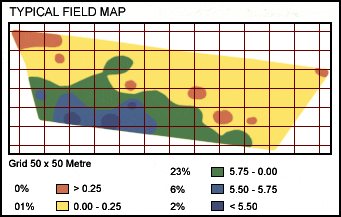Target pH equals profit
Compared with fertilisers, the application of natural quarried agricultural lime has long-term benefits.
However, despite taking longer to be effective, agricultural lime makes a tremendous difference to the productive potential of arable and grassland, both in real terms and in economic terms.
ALA members use skilled operators and modern well maintained machinery suitable for the land and type of lime being spread. Spreading should be even, accurate and cause little disruption to the soil structure. The operation should be carried out in accordance with the liming recommendations made at the time of sale and with due regard for the surrounding land and property.
If you are concerned about scheduling your lime operation into an already tight work programme talk to your ALA supplier about possible work options.
Lime spread carefully, with precision and accuracy, will enable maximum benefit to be obtained from every application. With ever increasing need to control and reduce inputs and maximise yields, the use of D.G.P.S. (Digital Global Positioning System) in producing soil maps combined with pH soil sampling must represent essential investment for the future.
The answer to the question 'How often should I lime?' is, in general, 'as often as necessary to maintain a pH as near enough 7.0 on arable, with permanent grassland at 6.5'. To achieve these soil pH values during the growing cycle, ALA recommends liming to Target pH values shown:

Liming may be carried out at any time when ground conditions are suitable. For arable land, lime is usually applied when the land is available after cropping. It is important to allow sufficient time for the soil to adjust to the correct pH before sowing. This can take several weeks, depending on the quality of lime used. It is particularly important to adjust soil pH well in advance of sensitive crops such as sugar beet, barley and peas.
Precision Field Mapping
The use of new precision technologies will help make the mapping of sites more accurate and potentially save time. The application of materials will then become more precise and cost effective. These are key aims of the ALA member companies in making lime recommendations

Depth of Penetration
When agricultural lime is applied as a top dressing it will affect the surface layers. With time, rain will gradually wash the material to lower soil layers. When a soil is very acid throughout its depth, or when the lower soil layers are significantly more acid than the surface layers, it is advisable to plough in half the lime dressing and spread the remaining half on the ploughed surface. If such soils are only surface dressed there is a likelihood that the roots of acid sensitive crops will reach the acid layers of the soil and result in the crops exhibiting stress symptoms due to calcium deficiency. |



